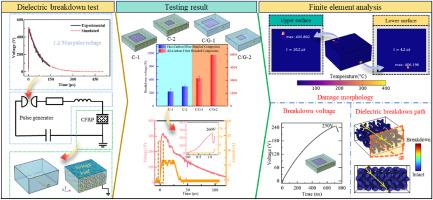Dielectric breakdown behaviors and high-voltage damages of 3D braided carbon fiber/epoxy resin composites
IF 9.8
1区 材料科学
Q1 MATERIALS SCIENCE, COMPOSITES
引用次数: 0
Abstract
Dielectric breakdown of carbon fiber reinforced polymers is a key factor affecting the lightning protection design of engineering applications. This paper presented a coupled phase field-electrical-thermal model to reveal dielectric breakdown evolution and damage morphology of three-dimensional (3D) braided carbon fiber/epoxy composites. Finite element analysis (FEA) results show that dielectric breakdown occurs in the shortest conductive path along the electrical field direction. The braided yarns outside the shortest path also exhibit a breakdown tendency, which weakens the dielectric breakdown voltage. Testing results verify that dielectric breakdown voltage decreases from 3250 V to 337.5 V as the increasing carbon fiber yarns. Increasing the equivalent length of braided yarn along the loading direction decreases the dielectric breakdown voltage. Furthermore, a similar elliptical damage is observed at the surface braided knot from both the FEA model and the testing results. The verified model finds that both electric potential and current density distributions within the composite undergo abrupt transitions upon complete dielectric breakdown, which further reveals the dielectric breakdown progress.

三维编织碳纤维/环氧树脂复合材料的介电击穿行为及高压损伤
碳纤维增强聚合物的介电击穿是影响工程应用防雷设计的关键因素。本文提出了一种相场-电-热耦合模型来揭示三维编织碳纤维/环氧复合材料的介电击穿演化和损伤形态。有限元分析结果表明,介质击穿发生在沿电场方向的最短导电路径上。在最短路径以外的编织纱线也表现出击穿的倾向,这削弱了介质击穿电压。测试结果表明,随着碳纤维纱的增加,介质击穿电压从3250 V降低到337.5 V。沿加载方向增加编织纱的等效长度可降低介质击穿电压。此外,从有限元模型和试验结果来看,编织结表面出现了相似的椭圆损伤。经过验证的模型发现,复合材料内部的电势和电流密度分布在介质完全击穿后都发生了突变,进一步揭示了介质击穿的过程。
本文章由计算机程序翻译,如有差异,请以英文原文为准。
求助全文
约1分钟内获得全文
求助全文
来源期刊

Composites Science and Technology
工程技术-材料科学:复合
CiteScore
16.20
自引率
9.90%
发文量
611
审稿时长
33 days
期刊介绍:
Composites Science and Technology publishes refereed original articles on the fundamental and applied science of engineering composites. The focus of this journal is on polymeric matrix composites with reinforcements/fillers ranging from nano- to macro-scale. CSTE encourages manuscripts reporting unique, innovative contributions to the physics, chemistry, materials science and applied mechanics aspects of advanced composites.
Besides traditional fiber reinforced composites, novel composites with significant potential for engineering applications are encouraged.
 求助内容:
求助内容: 应助结果提醒方式:
应助结果提醒方式:


